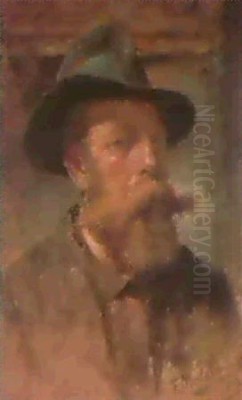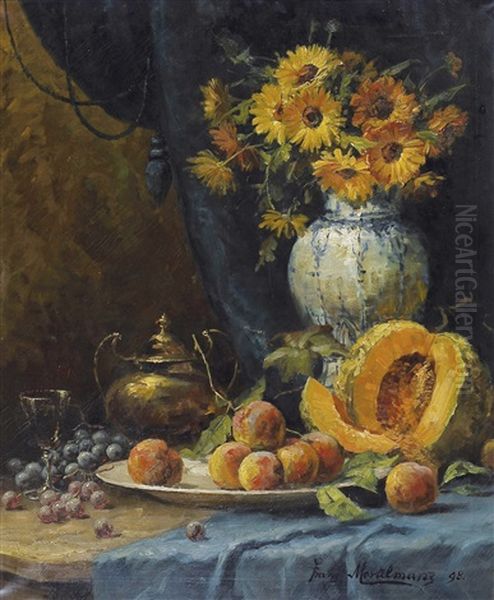
Frans Mortelmans stands as a significant figure in Belgian art history, primarily celebrated for his exquisite still life paintings, particularly those featuring flowers. Born in Antwerp in 1865 and passing away in 1936, Mortelmans navigated the artistic currents of his time, developing a distinctive style that blended elements of Realism and Impressionism, often imbued with a Luminist sensitivity to light. His work as a painter, draftsman, and engraver left a lasting legacy, appreciated both during his lifetime and by subsequent generations.
Early Life and Artistic Inclination
Frans Mortelmans was born in Antwerp on May 1, 1865. He was the eldest of six children born to Karel Mortelmans, a printer, and Isabella Poinjaert, who ran a stationery shop. Growing up in a middle-class environment, young Frans was initially encouraged towards music by his father, who even purchased a piano for him. However, Frans's true passion lay elsewhere.
Despite his father's musical aspirations for him, Frans Mortelmans ultimately chose the path of visual arts. This decision set him apart from his siblings, although artistic talent ran in the family; his younger brother, Lodewijk Mortelmans, would go on to become a renowned composer. Frans's commitment to painting marked the beginning of a long and dedicated artistic journey.
Formal Artistic Training
Mortelmans pursued his artistic education with diligence, spending a remarkable fifteen years honing his craft at prestigious Antwerp institutions. He studied extensively at the Royal Academy of Fine Arts in Antwerp and later at the Antwerp Higher Institute of Fine Arts. This prolonged period of training provided him with a solid foundation in academic principles and techniques.
During his formative years at the Academy, Mortelmans studied under influential instructors. The provided sources name Lucas Victor Schaefels and the prominent Belgian painter Charles Verlat as his teachers. The source material also lists Albrecht De Vriendt as one of his teachers, indicating a rich educational environment shaped by established artists of the time. This comprehensive training equipped him with the skills necessary for his future career.
Evolution of Artistic Focus

In the initial stages of his career, Frans Mortelmans explored various genres common within the academic tradition. He produced portraits, historical paintings, and genre scenes, demonstrating versatility and a command of different subject matters. These early works laid the groundwork for his technical proficiency.
However, Mortelmans gradually shifted his focus towards still life painting. It was in this genre, particularly the depiction of flowers, that he found his true calling and achieved his most significant success. His dedication to still life became the defining characteristic of his artistic output, especially during his peak creative period around the year 1900.
Distinctive Artistic Style
The artistic style of Frans Mortelmans is often described as occupying a space between Impressionism and Realism. His works exhibit a careful observation of reality, typical of Realism, yet are often rendered with a looser brushwork and a sensitivity to light and color that echoes Impressionist concerns. Furthermore, his paintings frequently possess a Luminist quality, emphasizing the effects of light on surfaces.
His compositions, particularly in his flower paintings, are noted for their harmony and strong decorative appeal. Mortelmans possessed a talent for arranging objects and floral elements in a visually pleasing and balanced manner. He employed a palette rich in vivid colors, applied with delicate brushwork, capturing what has been described as the "serene beauty" of his subjects. This blend of realism, light, color, and decorative sensibility defined his unique contribution.
Mastery of Still Life and Floral Subjects
Frans Mortelmans earned considerable fame for his still life paintings, with floral compositions becoming his signature subject. He displayed an exceptional ability to capture the delicate textures and vibrant colors of flowers, rendering them with both accuracy and artistic flair. His paintings of roses, especially pink roses, were particularly acclaimed and remain highly sought after.
The appeal of Mortelmans' still lifes extended beyond purely aesthetic appreciation. Their inherent decorative quality and the accessible beauty of the subject matter made them highly popular among the societal elite and the burgeoning middle class of his time. His works offered a sense of tranquility and elegance, resonating with the tastes of his contemporary audience and securing his reputation as a master of the genre.
Recognition and International Reach
Mortelmans' talent did not go unnoticed. He gained significant recognition within Belgium, becoming a well-regarded artist in his home country. His reputation also extended beyond national borders, particularly to Scandinavia. His works were exhibited and sold in Scandinavian countries, where they were warmly received by collectors and the public.
A significant milestone in his career occurred in 1903 when his work was officially recognized through acquisition by the prestigious Royal Museum of Fine Arts Antwerp. This institutional acknowledgment solidified his standing in the Belgian art world. Throughout his prolific career, Mortelmans created over 850 works, many of which have been cataloged, attesting to his dedicated output and enduring popularity.
Later Years and Documentation
In his later years, Frans Mortelmans turned his attention towards documenting the visual character of his native region. He created works depicting the landscapes and important historical monuments in and around Antwerp. This aspect of his oeuvre demonstrates a connection to his local environment and a desire to preserve its appearance through his art.
These later works, alongside his celebrated still lifes, found homes in public collections. Examples of his art, including these topographical studies, are preserved in museums in Antwerp and Ostend, ensuring their accessibility for future study and appreciation.
Context within Belgian Art
While Frans Mortelmans developed a highly personal style, his work can be situated within the broader context of Belgian art at the turn of the 20th century. His emphasis on decorative qualities aligns with the strong tradition of decorative painting prevalent in Belgium during the late 19th and early 20th centuries. This tradition was part of the artistic milieu that also included figures like James Ensor, although Mortelmans did not belong to Ensor's specific avant-garde circle.
Despite stylistic affinities with Impressionism and Luminism, Mortelmans is not typically classified as a core member of any major international art movement. His career unfolded primarily within the Belgian academic and decorative traditions, absorbing contemporary influences while maintaining a distinct artistic identity focused on meticulous craftsmanship and aesthetic appeal.
Associated Names and the Ptarmigan Project Context
It is important to note a specific point arising from the source materials used for this overview. These sources mention Frans Mortelmans in connection with a "Ptarmigan project" and list numerous individuals associated with it. These names include: Gene Coleman, Audrey Chen, Werner Moebius, Mariella Greil, Christian Schroeder, Michael McDermott, J.H.J. Phillips, Maria Nurmela, JIMO Taylor, Marina Petrova, Helena Espvall, Kimmo Modig, Martin Lanz Landazuri, Topias Danieli, Daniela Lehman, Klaus Janek, and Antje Velsing.
The context provided for some of these individuals (e.g., Gene Coleman as a musician, Werner Moebius involved with music and mathematics, Mariella Greil as an artist and dancer, and confusion regarding Christian Schroeder with a scientist studying Ptarmigan birds) suggests that these associations likely pertain to a contemporary project or context distinct from the historical painter's own lifetime and direct artistic collaborations. While the source links these names, their fields (music, dance, sound art) and the project name itself indicate a probable disconnect from Frans Mortelmans' primary work as a painter active from the late 19th to early 20th century. This information is included here as it was present in the source material, but should be understood within that specific, potentially separate, context.
Legacy and Conclusion
Frans Mortelmans remains a respected and cherished figure in Belgian art history, primarily celebrated for his mastery of still life painting. His ability to combine realistic detail with impressionistic light and color, all within harmoniously composed and decorative frameworks, resulted in works of enduring beauty. His flower paintings, in particular, continue to captivate viewers with their elegance and technical brilliance.
Educated by notable figures like Lucas Victor Schaefels and Charles Verlat, and working within a rich Belgian artistic tradition alongside contemporaries contextually linked to figures such as James Ensor, Mortelmans carved out his own niche. His prolific output, recognized by institutions like the Royal Museum of Fine Arts Antwerp and appreciated by a wide public, secures his legacy. Frans Mortelmans' paintings stand as testaments to a dedicated artistic vision focused on capturing the serene beauty of the everyday, rendered with exceptional skill and sensitivity.